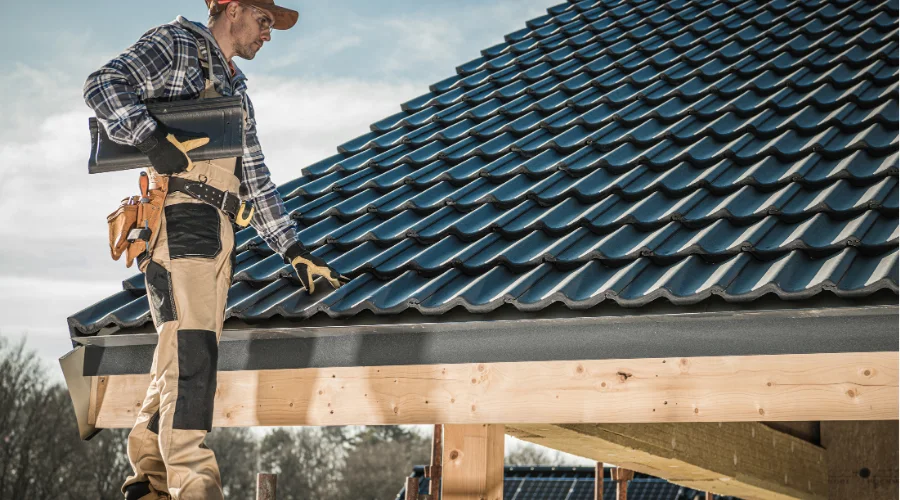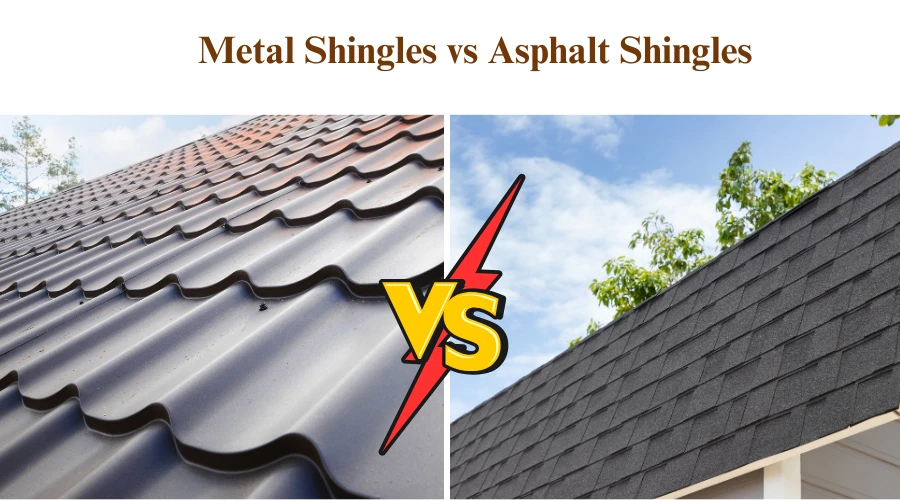Metal shingles are a common roofing material that is profoundly used across the country. They have gained popularity among homeowners with their unique trends and styles in the roofing industry. They can give an excellent outlook and give your house protection against harsh weather conditions and other outdoor elements.
In this Brick & Bolt article, we will explore the types, advantages, and differences between metal shingles and asphalt shingles and other information in detail.
What Are Metal Shingles?
Metal shingles are one of the popular roofing materials that replicate conventional roofing, asphalt, tile, or slate with high-quality metal like steel for achieving superior strength and performance.
These can use modern manufacturing methods like precision stamping and specialised coating over the outer layer to make them more resilient.
They are available in various types, colours, and styles. You can choose your best under your budget and design requirements.
Types of Metal Shingles
The following are some typical kinds of metal roof shingles:
- Aluminium Shingles
They are light in weight and also rust-proof by nature, thus ideal for coastal or wet conditions. They improve energy efficiency by efficiently reflecting heat.
- Copper Shingles:

You may experience a royal outlook for your space with its resilient and long-lasting nature. Usually, a green film can form naturally on copper over time. Even though they are more expensive than other metal roofing options. These can last from 60 to 100 years.
- Steel Shingles
These are known for their resilience and strength, Steel Shingle Roof systems are often protected against rust and corrosion. They are popular for their durability, available in various colours and styles, and can last nearly 70 years even in harsh weather conditions.
- Zinc Shingles
These are commonly used and have moderate prices to accommodate. As time rolls on, these shingles also form a protective layer against any outdoor elements.
- Stone-Coated Steel Shingles
A strong steel base and a stone granule coating give these shingles a traditional look. to provide strong support for the structure. They work well against fire and harsh weather and last up to 40 years.
Advantages of Metal Shingles
Several advantages of metal shingles are as follows:
- These shingles are made of various metals, which determine cost, weight, and attractiveness.
- These are durable enough to endure harsh weather conditions such as massive wind, rain, or heat.
- Compared to the old ones, these can perform better after being in use for over 40 years.
- As they are light in weight, they open the way for simple installation, and they exert less stress on the building where they are installed.
- They reduce additional cooling costs for the structure by reflecting the heavy sunlight in overall weather conditions.
- They are highly resistant to fire and add additional protection to every structure.
- They are flexible in design by complementing any home’s aesthetic appeal and are available in numerous styles and colours.
- As they use an interlocking system in their installations, they offer more security against harsh weather.
- Moreover, metal shingles are recyclable products of modern architecture.
- They are worth your investment due to their resilience and low maintenance.
Metal Shingles vs. Asphalt Shingles

The differences between metal shingles and asphalt shingles are discussed below:
| Features | Metal Shingles | Asphalt Shingles |
| Permanence | They are sturdy and can withstand extreme weather, snowfall, and high winds. | They are less durable and more prone to weather damage. |
| Lifespan | They can last 40+ years with proper care. | They can last 15–30 years, depending on quality and climate. |
| Maintenance | They need very little maintenance and are resistant to rot, insects, and mildew. | They require low maintenance but may need repairs after harsh weather. |
| Energy Efficiency | They reflect sunlight, keeping the house cooler and reducing energy bills. | They absorb heat, making the house warmer and increasing cooling costs. |
| Installation | They are lightweight and easy to install with the proper technique. | They are easy to install and are often used in DIY projects. |
| Cost | They require more cash initially but save money long-term due to durability and low maintenance. | They are cheap but may require more repairs and are prone to harsh weather. |
| Appearance | They are available in many styles and colours, giving a modern and stylish look. | They come in various colours and styles, offering a classic home appearance. |
Installation Process of Metal Shingles
Most metal shingles are easy to install without the use of specialised tools due to their four-way interlocking design. Following is the step by step process of installing metal shingles.
Step:1 Preparation of Roof Deck
- Strong materials, including gap-free plywood or wood boards, are needed for the roof deck.
- Metal shingles may be installed on top of one layer if you have only one asphalt shingle.
Step: 2 Installing Underlayment
- A breathable synthetic underlayment is employed above the deck to exclude moisture and prevent the wood from rotting.
- It overlaps every row by about six inches and is secured with special nails as you move up the roof.
Step: 3 Installation of Trims and Flashing
- To guide water away, a starter flashing or drip edge is attached to the edge of the roof.
- Use galvanised steel nails for steel shingles and aluminium nails for aluminium shingles to avoid rusting.
- The gable flashing should be placed on top of the drip edge flashing at the edge of the roof.
- Flashing is applied on walls and chimneys to seal joints and prevent leaks.
- There are approximately two feet of solid decking left on each side of the ridge after vent pipes and ridge vents have been cut through for openings.
Ste: 4 Installing Metal Shingles
- To ensure straight shingles, utilise chalk lines.
- Begin with half shingles on the left and proceed upward to full shingles.
- Raise progressively each row of shingles while installing diagonally.
- Install interlocking ridge caps and ridge vents to cover the peak once you reach the ridge.
Step: 5 Ventilation
- To maximise airflow, install a ridge vent if you have soffit vents in the roof.
Maintenance and Care for Metal Shingles
To maintain metal shingles in optimal condition, clean, inspect, and check for damage on a regular basis.
- Check the roof for loose or broken metal shingles periodically to keep them in good shape.
- Water accumulation can be avoided by cleaning dirt and debris.
- Check for rust or corrosion, particularly at fasteners.
- Check regularly that flashing and seals on vents and chimneys are still intact.
- If needed, wash the surface with water and soap.
- Periodic maintenance of the roof keeps the roof new and increases its lifespan.
Conclusion
In conclusion, metal shingles are a fantastic choice to decorate your home with their long-lasting property. If you are looking for a professional roofing service, we at Brick and Blot offer tremendous choice and give you suggestions on which shingles may fit your home for its elegant appearance and excellent performance. We will also assist you in choosing the right material that fits your home and budget well. Call our experts and get your quote from our experts.

